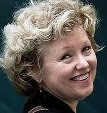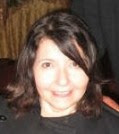
by Sharon Vanderlip, DVM
This is my first blog. From what I can tell, blogging is a bit like talking to strangers...something my parents told me I should never do...but they also told me "You're not going to college! Get a good waitress job!" Sometimes you just have to disobey.
My parents also told me to never pet "strange" dogs. One day, when I was ten, I was running errands for my mother when I spotted a dog sitting outside the grocery store. As I reached out to pet it, the dog promptly bit my hand. Oooooooohhhh, there was blood! A concerned crowd quickly gathered. A friendly policeman took me on an exciting ride in the backseat of a cop car to the hospital, where all the doctors and nurses were kind and fussed over me. They gave me a tetanus shot and covered my wound with brightly colored band-aids adorned with stars and assured me I'd be fine. I couldn't wait for show-and-tell at school the next day! But things took a nosedive when my father came home from work. If he was happy I was alive, it didn't show. He had a short fuse and was highly volatile. This wasn't my first offense. Not long ago, another dog had mildly mauled me when I tried to pet it. My father was furious with me for disobeying. He insisted that the doctors were wrong and unless the "strange" dog was found and proven to be vaccinated, I would surely need multiple painful abdominal injections with very large bore needles, 19th century Pasteur-style. Otherwise, I would get rabies, froth at the mouth, have violent seizures, and be grateful to finally drop dead. He let me contemplate these consequences overnight, wide-eyed with pounding heart, until the following morning when my sentence was pronounced. My father's favorite punishment for all of my crimes, large and small, was to make me "write lines". The penalty for petting a "strange" dog? I had to write "I will not pet strange dogs anymore" ten thousand times. It's true. I had thirty days to complete the assignment or my father would double it, so I had to write very fast before the rabies virus finished incubating and I lost all neurological control.
So, what became of me after a childhood of grueling line writing and being a living chew toy for various animals? I became a veterinarian and an author! Proof positive that negative reinforcement doesn't work!
You can be a successful author if you are willing to work hard, be persistent, and tolerate a lot of criticism and rejections. All easier said than done, of course, so here are ten tips that may help you in your endeavors:
1. Write for yourself and for your own enjoyment.
2. Write about the things that you love or that fascinate you.
3. Write every day, even if it's only a little bit.
4. Read lots of books on your favorite topics, written by authors who inspire you.
5. Identify your reading audiences and discover what they want to learn from you.
6. Consider self-publishing your book.
7. Save several copies of your work.
8. Be persistent and don't give up!
9. Be vigilant! Things can go awry during and after your book's publication.
10. Design a great book cover!
Since childhood, I loved to write everything (except "lines"). In my mind, an author was anyone who had a reading audience. My audiences were weary teachers and a room full of bored classmates held hostage and forced to listen until the bell rang. Good enough! I wrote lots of wild stories during grade school. I wrote my first Collie book in eighth grade. I self-published my second Collie book in 1984 and am now working on a new Collie book. I adore Collies. Besides, a Collie would never bite a little girl outside the grocery store.
My awakening occurred while I was working on my bachelor of science degree, majoring in zoology at the University of California, Davis. Loren Eiseley's The Immense Journey was required reading. I was smitten. That small book of lyrical prose ignited my desire to become a true naturalist and a good writer and launched me on a journey of my own. Since that time I have read numerous books about natural history by leading naturalists. My favorite authors are Loren Eiseley, Tim Flannery, and Edward O. Wilson (of ant fame).
After graduating from veterinary school, I served as clinical veterinarian for the University of California San Diego, School of Medicine. My first works were published in scientific journals and included such intriguing topics as congestive heart failure in a striped skunk, ovulation induction in dogs, and health care and biological values for endangered Chinese pangolins (a species of scaly anteaters, sometimes eaten as a delicacy or turned into boots). Writing scientific articles teaches important writing skills: do original research, verify sources, don't reference references, be accurate, and acknowledge others for their work.
When Barron's Educational Series, Inc. asked me if I could write Dwarf Hamsters Pet Manual, I gave the editor a copy of my book, The Collie—A Veterinary Reference for the Professional Breeder, as a sample of my writing. This self-published book served as my stepping stone into a new realm of book writing and publishing. Good thing, too, because I couldn't print and sell more Collie books due to a shipping agent mix-up. Long story, but the Cliffs Notes version is that all of my Collie book materials were inadvertently shipped to a mission in the remote mountains of Peru, where they were never seen again— and I received several pounds of prayer pamphlets (in Spanish, Aymara, and Quechua) that were intended for the mission. My Collie book was lost in the Andes, but at least it helped me earn a place with Barron's. Now I could write books about pet care for the general public. Because my specialty is animal reproduction, I could legitimately add a little bit of animal sex in some chapters, just to spice it up. After all, dwarf hamsters have the shortest reproductive cycle of any placental mammal (16 days!). They can breed immediately after giving birth and can be pregnant and lactate at the same time. Who isn't interested in that?
Dwarf Hamsters Pet Manual was such a smash that Barron's invited me to write several more rodent reality books, but these didn't go as smoothly. All but my Guinea Pig Handbook were fraught with problems. The cover of my Chinchilla Handbook was initially misspelled. Don't ask. The cover of my Mice Pet Manual still depicts the wrong species, an Egyptian spiny mouse. I received nasty letters from some prairie dog aficionados because the cover of my Prairie Dogs Pet Manual (a photo selected by Barron's after I specifically rejected it) portrayed an obese prairie dog eating a corn chip. Obesity is the number one cause of mortality in pet prairie dogs, so the book cover did little to convince readers that I knew my stuff. But it got worse. Shortly after the release of Prairie Dogs Pet Manual, a government ban on prairie dog ownership went into effect. My book languished on the store shelves, so Barron's took it out of print and returned the copyright to me. The prairie dog ban was enforced because the Center for Disease Control thought prairie dogs might be spreading small pox. When the CDC confirmed that this wasn't the case and that the culprits were a Gambian rat and monkey pox virus, the ban was lifted...years later...and so was my work. I keep finding websites where people are copying and selling my prairie dog book without my permission. Oh-oh. Time to talk to a copyright attorney.
I have also written several dog breed books for Barron's and this year my Hedgehogs Pet Manual was released. These little spiny animals are one of the most primitive creatures alive on our planet today. Admit it, you are wondering how they mate and give birth with all those quills, right?
We all take different paths to become published authors. Whatever route you take, plan on it being bumpy.
Sharon Vanderlip, DVM is the author of more than 20 books and numerous articles on animal care. For more information please visit her website www.sharonvanderlip.com












3 comments:
Thanks, Sharon! A great article--one would NEVER know it was your first blog. Well done!
Love it, love it! Great job!
Sharon--I absolutely LOVE Loren Eiseley's THE IMMENSE JOURNEY. It is sheer poetry and some of the wisest words ever written. And as always, you make me laugh!
Post a Comment